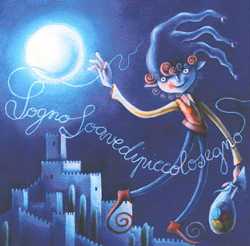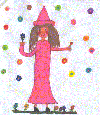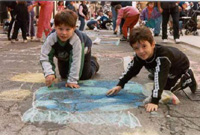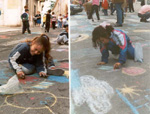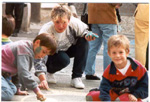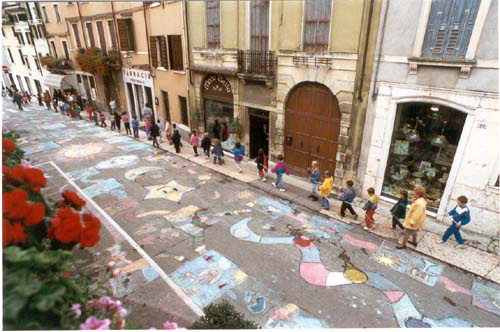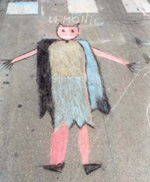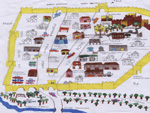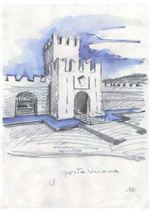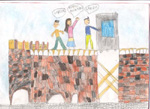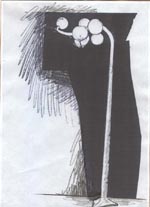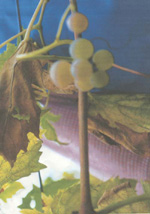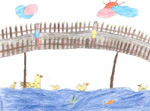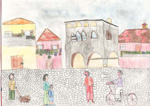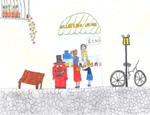 |
![]() The
story
The
story
of the sprite in the castle
![]()
![]()
Here is the first story travelling
between Soave and Latina.
![]()
GESSETTO
__________
CHALKY,
THE CASTLE PIXY
![]()
By
the light of the moon he’d come out of the tallest tower in the
castle…
Chalky was the castle pixy. He skipped lightly over the battlements with his quaint pointy hat and his magic wand with its three little bells.
That
moonlit night he’d come somersaulting down Via Roma to grant the
children’s wishes that nobody had listened to, and he’d left lots
of little heaps of coloured chalk along the road.
"How happy they’ll be when they find them”, he thought. “They’ll be able to draw their dreamsi". He’d prepared the chalk after searching in an old book and getting advice from the flower fairy, who lived nearby among the ruins of Illasi castle.
She was a real expert with colours! She always went round with a bag containing all you need to look after wild flowers. Every year, before winter arrived, she got out a large trunk and said the magic spell to catch all the colours, and then left them there to rest till spring came:
To
make red and orange, Chalky caught two rays of the setting sun,
and then took emerald green from a scented mintleaf. As
it was autumn he collected some brown from the leaves in his
gardening apron. Purple? The petals of a violet were enough,
and then he leapt towards the sky to catch his blues. And
so it was that Lorenzo, leaving home for school just like every
morning, saw drawings on the tarmac: a pink boat, then a blue
horse, and a patch of grass full of flowers a few steps further
on.
“Whoever can have done these drawings?” Lorenzo asked. "I
know”, answered Celestina, a granny who lived near the Courthouse,
and saw him entranced by the pictures. “It was the castle pixy.
Last night was full moon and he came out on his merry round!”. "Oh, he’s a cheery chap, he slips in among the clouds and runs after them, hither and thither, just like the wind. As soon as he sees the moon round as a silvery ball, he goes from house to house, from the Covergnino quarter to Bassanella, collecting the children’s dreams. And sometimes he plays games without being seen: he hides in the castle chambers and plays tricks on the young couples and the nosy tourists”, said Celestina. “I remember once…” Lorenzowasn’t listening to her any more. He ran to school and told his mates everything he’d seen and heard, all in one breath. Then the children and teachers went out to look for the coloured traces the pixy had left the night before. As they went they found lots of brightly coloured chalks and ribbons, and in their small hands these traces turned into…dreams. “That
pink was pale and light…”.
"You could see the white so well, it was smooth"
"The black dust of the charcoal stick made me cough…”
"The yellow chalk was just so soft!”
"And the green was easy to colour with too" "“But
the red was hard and made a great old noise on the tarmac!”
Somebody started the game of writing a dream on a little bit of paper, then tying it to the ribbon next to someone else’s dream, and then another, and yet another… ending up with a long, multicoloured paper chain with all the dreams collected along the street.
Perhaps
now you’re wondering what happened to the drawings.
But
though the children’s drawings and cheeriness had been erased,
the bundle of their dreams tied together as messages was still
there, and they wanted to transform them into reality! So they went out to have another look at the old heart of their little town, and that way they rediscovered its hidden face, the voice and the story of its alleys, its squares and streets, still alive today.
The
pixy eyed them curiously from the castle keep while they were
happily planning and drawing Soave, using the special colours
and little models which state important wishes. “I’d like the Verona gate to have a drawbridge over a moat, with the river Tramigna flowing quietly along it. That way we could go into town on foot eating an icecream".
“I’d
like to revive the walks in the town centre used by the medieval
guards when they did sentry duty on the towers. A museum in the towns
"I’d like a museum exhibiting clothing, tools, portraits and other things from the middle ages, and also the tools our grandparents used when they worked in the fieldsi".
"It’d be lovely to light up Via Roma with the right sort of street lamps, it’d make the old town centre look more fascinating in the evening".
"If the river Tramigna was cleaner the fish would live a long time and you could go fishing. We’d like there to be more ducklings and swans"
"If the river Tramigna was cleaner the fish would live a long time and you could go fishing. We’d like there to be more ducklings and swans” “We
want a cleaner and more welcoming playground, and we’d especially
like the corners set aside for little children to be respected. “I’d like Via Roma with no cars or scooters, decorated with tiles like mosaics. They could put flowerbeds down the sides and I’d set up a prize competition for the finest flowers on the balconies.”
"I’d
like Piazza Mercato dei Grani to become the children’s square,
with brightly coloured flowerbeds and parking for bikes. “You
see”, Chalky said,“the Space of Times Gone By lives on in the
little grownups of tomorrow”.
|
||||||||||||||||||||||||||||
Special thanks to him
![]()
|
![]()
